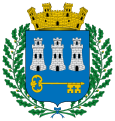Havana
| Havana La Habana |
|||
|
|
|||
|
|||
| Nickname(s): Ciudad de las Columnas (Spanish) " City of Columns " |
|||
 |
|||
| Coordinates: | |||
| Country | |||
|---|---|---|---|
| Province | Ciudad de La Habana | ||
| Founded | 1515a | ||
| Municipalities |
15
|
||
| Government | |||
| - Mayor | Juan Contino Aslán (PCC) | ||
| Area | |||
| - City | 721.01 km² (278.4 sq mi) | ||
| Elevation | 59 m (194 ft) | ||
| Population (2005 & 2006 est)[1][2] | |||
| - City | 2,400,300 | ||
| - Density | 3,053.5/km² (7,908.5/sq mi) | ||
| - Urban | 2,700,200 | ||
| - Metro | 3,710,100 | ||
| Time zone | EST (UTC-5) | ||
| - Summer (DST) | EDT (UTC-4) | ||
| Postal code | 10xxx-19xxx | ||
| Area code(s) | (+53) 7 | ||
| a Founded on the present site was founded in 1519. | |||
Havana (Spanish: La Habana, IPA: [la aˈβana], officially Ciudad de La Habana[3], is the capital city, major port, and leading commercial centre of Cuba. The city is one of the 14 Cuban provinces. The city/province has 2.1 million inhabitants, and the urban area over 3.5 million, making Havana the largest city in both Cuba and the Caribbean region.[4] The city extends mostly westward and southward from the bay, which is entered through a narrow inlet and which divides into three main harbours: Marimelena, Guanabacoa, and Atarés. The sluggish Almendares River traverses the city from south to north, entering the Straits of Florida a few miles west of the bay.
King Philip II of Spain granted Havana the title of City in 1592 and a royal decree in 1634 recognized its importance by officially designated as the "Key to the New World and Rampart of the West Indies".[5] Havana's coat of arms carries this inscription. The Spaniards began building fortifications, and in 1553 they transferred the governor's residence to Havana from Santiago de Cuba on the eastern end of the island, thus making Havana the de facto capital. The importance of harbour fortifications was early recognized as English, French, and Dutch sea marauders attacked the city in the 16th century.[6] The sinking of the U.S. battleship Maine in Havana's harbor in 1898 was the immediate cause of the Spanish-American War[7].
Nowadays Havana is the center of the Cuban government, and various ministries and headquarters of businesses are based there.
Contents |
Etymology
(UN/LOCODE: CU HAV) La Habana, was founded and formerly named as Villa de San Cristóbal de la Habana by Diego Velásquez de Cuellar. The name Habana is probably based upon the name of a local Taíno chief Habaguanex. An alternate theory is that Habana is derived from the Middle Dutch word havene, referring to a port, but as Havana was not originally founded as a port, this origin appears improbable[8].
Ciudad de La Habana, meaning "City of Havana," is considered a province, despite its name. In common usage, La Habana is translated when in reference to the city (Havana in Dutch, English, and Portuguese; La Havane in French; L'Avana in Italian; Havanna in German), but not when in reference to either of the provinces.
History
The founding of Havana
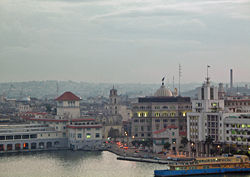
The current Havana area and its natural bay were first visited by Europeans during Sebastián de Ocampo's circumnavigation of the island in 1509.[9] Shortly thereafter, in 1510, the first Spanish colonists arrived from Hispaniola and began the conquest of Cuba.
Conquistador Diego Velázquez de Cuéllar founded Havana on August 25, 1515 on the southern coast of the island, near the present town of Surgidero de Batabanó. Between 1514 and 1519, the city had at least two different establishments. All attempts to found a city on Cuba's south coast failed. The city's location was adjacent to a superb harbor at the entrance to the Gulf of Mexico, and with easy access to the Gulf Stream, the main ocean current that navigators followed when traveling from the Americas to Europe. This location led to Havana’s early development as the principal port of Spain's New World colonies. An early map of Cuba drawn in 1514 places the town at the mouth of the river Onicaxinal, also on the south coast of Cuba. Another establishment was La Chorrera, today in the neighbourhood of Puentes Grandes, next to the Almendares River.

The final establishment, commemorated by El Templete, was the sixth town founded by the Spanish on the island, called San Cristobal de la Habana by Pánfilo de Narváez: the name combines San Cristóbal, patron saint of Havana, and Habana, of obscure origin, possibly derived from Habaguanex, an Indian chief who controlled that area, as mentioned by Diego Velasquez in his report to the king of Spain. A legend relates that Habana was the name of Habaguanex's beautiful daughter,[10] but no known historical source corroborates this version.
Havana moved to its current location next to what was then called Puerto de Carenas (literally, "Careening Bay"), in 1519. The quality of this natural bay, which now hosts Havana's harbor, warranted this change of location. Bartolomé de las Casas wrote:
...one of the ships, or both, had the need of careening, which is to renew or mend the parts that travel under the water, and to put tar and wax in them, and entered the port we now call Havana, and there they careened so the port was called de Carenas. This bay is very good and can host many ships, which I visited few years after the Discovery... few are in Spain, or elsewhere in the world, that are their equal...[9]
Shortly after the founding of Cuba's first cities, the island served as little more than a base for the Conquista of other lands. Hernán Cortés organized his expedition to Mexico from the island. Cuba, during the first years of the Discovery, provided no immediate wealth to the conquistadores, as it was poor in gold, silver and precious stones, and many of its settlers moved to the more promising lands of Mexico and South America that were being discovered and colonized at the time. The legends of Eldorado and the Seven Cities of Gold attracted many adventurers from Spain, and also from the adjacent colonies, leaving Havana and the rest of Cuba largely unpopulated.
Pirates and La Flota



Havana was originally a trading port, and suffered regular attacks by buccaneers, pirates, and French corsairs. The first attack and resultant burning of the city was by the French corsair Jacques de Sores in 1555. The pirate took Havana easily, plundering the city and burning much of it to the ground. De Sores left without obtaining the enormous wealth he was hoping to find in Havana. Such attacks convinced the Spanish Crown to fund the construction of the first fortresses in the main cities — not only to counteract the pirates and corsairs, but also to exert more control over commerce with the West Indies, and to limit the extensive contrabando (black market) that had arisen due to the trade restrictions imposed by the Casa de Contratación of Seville (the crown-controlled trading house that held a monopoly on New World trade).
To counteract pirate attacks on galleon convoys headed for Spain while loaded with New World treasures, the Spanish crown decided to protect its ships by concentrating them in one large fleet, which would traverse the Atlantic Ocean as a group. A single merchant fleet could more easily be protected by the Spanish Armada. Following a royal decree in 1561, all ships headed for Spain were required to assemble this fleet in the Havana Bay. Ships arrived from May through August, waiting for the best weather conditions, and together, the fleet departed Havana for Spain by September.
This naturally boosted commerce and development of the adjacent city of Havana (a humble villa at the time). Goods traded in Havana included gold, silver, alpaca wool from the Andes, emeralds from Colombia, mahoganies from Cuba and Guatemala, leather from the Guajira, spices, sticks of dye from Campeche, corn, manioc, and cocoa. Ships from all over the New World carried products first to Havana, in order to be taken by the fleet to Spain. The thousands of ships gathered in the city's bay also fueled Havana's agriculture and manufacture, since they had to be supplied with food, water, and other products needed to traverse the ocean. In 1563, the Capitán General (the Spanish Governor of the island) moved his residence from Santiago de Cuba to Havana, by reason of that city's newly gained wealth and importance, thus unofficially sanctioning its status as capital of the island.
On December 20, 1592, King Philip II of Spain granted Havana the title of City. Later on, the city would be officially designated as "Key to the New World and Rampart of the West Indies" by the Spanish crown. In the meantime, efforts to build or improve the defensive infrastructures of the city continued. The San Salvador de la Punta castle guarded the west entrance of the bay, while the Castillo de los Tres Reyes Magos del Morro guarded the eastern entrance. The Castillo de la Real Fuerza defended the city's centre, and doubled as the Governor's residence until a more comfortable palace was built. Two other defensive towers, La Chorrera and San Lázaro were also built in this period.
17th-19th centuries
Havana expanded greatly in the 17th century. New buildings were constructed from the most abundant materials of the island, mainly wood, combining various Iberian architectural styles, as well as borrowing profusely from Canarian characteristics. During this period the city also built civic monuments and religious constructions. The convent of St Augustin, El Morro Castle, the chapel of the Humilladero, the fountain of Dorotea de la Luna in La Chorrera, the church of the Holy Angel, the hospital of San Lazaro, the monastery of Santa Teresa and the convent of San Felipe Neri were all completed in this era.
In 1649 a fatal epidemic brought from Cartagena in Colombia, affected a third of the population of Havana. On November 30, 1665, Queen Mariana of Austria, widow of King Philip IV of Spain, ratified the heraldic shield of Cuba, which took as its symbolic motifs the first three castles of Havana: the Real Fuerza, the Tres Santos Reyes Magos del Morro and San Salvador de la Punta. The shield also displayed a symbolic golden key to represent the title "Key to the Gulf". On 1674, the works for the City Walls were started, as part of the fortification efforts. They would be completed by 1740.
By the middle of the 18th century Havana had more than seventy thousand inhabitants, and was the third largest city in the Americas, ranking behind Lima and Mexico City but ahead of Boston and New York.[11]
The city was captured by the British during the Seven Years' War. The episode began on June 6, 1762, when at dawn, a British fleet, comprising more than 50 ships and a combined force of over 11,000 men of the Royal Navy and Army, sailed into Cuban waters and made an amphibious landing east of Havana.[12] The invaders seized the heights known as La Cabaña on the east side of the harbor and commenced a bombardment of nearby El Morro Castle, as well as the city itself. After a two month siege[13], El Morro was attacked and taken on 30 July 1762. The city formally surrendered on 13 August.[12] It was subsequently governed by Sir George Keppel on behalf of Great Britain. Although the British only lost 560 men to combat injuries during the siege, more than half their forces ultimately died due to illness, yellow fever in particular.
The British immediately opened up trade with their North American and Caribbean colonies, causing a rapid transformation of Cuban society. Food, horses and other goods flooded into the city, and thousands of slaves from West Africa were transported to the island to work on the undermanned sugar plantations.[13] Though Havana, which had become the third largest city in the new world, was to enter an era of sustained development and strengthening ties with North America, the British occupation was not to last. Pressure from London by sugar merchants fearing a decline in sugar prices forced a series of negotiations with the Spanish over colonial territories. Less than a year after Havana was seized, the Peace of Paris was signed by the three warring powers thus ending the Seven Years' War. The treaty gave Britain Florida in exchange for Cuba on the recommendation of the French, who advised that declining the offer could result in Spain losing Mexico and much of the South American mainland to the British.[13]



After regaining the city, the Spanish transformed Havana into the most heavily fortified city in the Americas. Construction began on what was to become the Fortress of San Carlos de la Cabaña, the biggest Spanish fortification in the New World. The work extended for eleven years and was enormously costly, but on completion the fort was considered an unassailable bastion and essential to Havana's defence. It was provided with a large number of cannons forged in Barcelona. Other fortifications were constructed, as well: the castle of Atarés defended the Shipyard in the inner bay, while the castle of El Príncipe guarded the city from the west. Several cannon batteries located along the bay's canal (among them the San Nazario and Doce Apóstoles batteries) ensured that no place in the harbor remained undefended.
The Havana cathedral was constructed in 1748 as a Jesuit church, and converted in 1777 into the Parroquial Mayor church, after the Suppression of the Jesuits in Spanish territory in 1767. In 1788, it formally became a Cathedral. Between 1789 and 1790 Cuba was apportioned into an individual diocese by the Roman Catholic Church. On January 15, 1796, the remains of Christopher Columbus were transported to the island from Santo Domingo. They rested here until 1898, when they were transferred to Seville's Cathedral, after Spain's loss of Cuba.
Havana's shipyard (named El Arsenal) was extremely active, thanks to the lumber resources available in the vicinity of the city. The Santísima Trinidad was the largest warship of her time. Launched in 1769, she was about 62 meters long, had three decks and 120 cannons. She was later upgraded to as many as 144 cannons and four decks. She sank following the Battle of Trafalgar in 1805. This ship cost 40.000 pesos fuertes of the time, which gives an idea of the importance of the Arsenal, by comparing its cost to the 26 million pesos fuertes and 109 ships produced during the Arsenal's existence.[14]
As trade between Caribbean and North American states increased in the early 19th century, Havana became a flourishing and fashionable city. Havana's theaters featured the most distinguished actors of the age, and prosperity amongst the burgeoning middle-class led to expensive new classical mansions being erected. During this period Havana became known as the Paris of the Antilles.
The 19th century opened with the arrival in Havana of Alexander von Humboldt, who was impressed by the vitality of the port. In 1837, the first railroad was constructed, a 51 km stretch between Havana and Bejucal, which was used for transporting sugar from the valley of Guinness to the harbor. With this, Cuba became the fifth country in the world to have a railroad, and the first Spanish-speaking country. Throughout the century, Havana was enriched by the construction of additional cultural facilities, such as the Tacon Teatre, one of the most luxurious in the world, the Artistic and Literary Liceo (Lyceum) and the theater Coliseo.
In 1863, the city walls were knocked down so that the metropolis could be enlarged. At the end of the century, the well-off classes moved to the quarter of Vedado. Later, they emigrated towards Miramar, and today, evermore to the west, they have settled in Siboney. At the end of the 19th century, Havana witnessed the final moments of Spanish colonialism in America, which ended definitively when the United States warship Maine was sunk in its port, giving that country the pretext to invade the island. The 20th century began with Havana, and therefore Cuba, under occupation by the USA. In 1906 the Bank of Nova Scotia opened the first branch in Havana. By 1931 it had three branches in Havana.
Republican period and Post-revolution
Under American influence, the city grew and prospered. Numerous residencies, luxury hotels, casinos and nightclubs were constructed since the 1930s to serve Havana's burgeoning tourist industry. Santo Trafficante, Jr. took the roulette wheel at the Sans-Souci, Meyer Lansky directed the Riviera, Lucky Luciano, the National Casino, and the Havana Hilton was Latin America's tallest, largest hotel. At the time Havana became an exotic capital of appeal and numerous activities ranging from marinas, grand prix car racing, musical shows, parks, etc.
Havana achieved being the Latin American city with the biggest middle class per-capita simultaneously accompanied by gambling and corruption where gangsters and stars were known to mix socially. During this era Havana was usually producing more revenue than Las Vegas. A gallery of black and white portraits from the era still adorns the walls of the bar of the National Hotel, including pictures of Frank Sinatra with Ava Gardner, Marlene Dietrich and Gary Cooper. In 1958 about 300,000 American tourists visited the city. One of the most well-known to the world was the American author Ernest Hemingway (1899-1961), who quoted "in terms of beauty, only Venice and Paris surpassed Havana", Hemingway wrote several of his famous novels in Cuba and lived there the last 22 years of his life.[15]
After the revolution of 1959 promises were made to improve social services, public housing, and official buildings; nevertheless, shortages that affected Cuba following Fidel Castro's abrupt declaration of Cuba as a one party communist state and with it the nationalization of all private property and businesses on the island (foreign and national), followed by the U.S. embargo, hit Havana especially hard. By 1966-68, the Cuban government had nationalized all privately owned business entities in Cuba, down to "certain kinds of small retail forms of commerce" (law No. 1076 [4]). Today much of the city is in a vast dilapidated state and crumbling, with its citizens not having the monetary ability nor the government authorization to preserve the old buildings from the effects of the tropical climate and occasional hurricanes.
Following a severe economic downturn after the collapse of the Soviet Union in 1991 and with it the end of the billions of dollars in subsidies the Soviet Union gave the Cuban government, many believed Havana's Soviet maintained government would soon vanish, as it happened in Eastern Europe. However, the socialist government increasingly turned to tourism for financial support. Most of this new tourism comes from Canada and western European nations, amounting to approximately 2 billion dollars annually according to National Geographic. An effort has gone into rebuilding Old Havana for tourist purposes and a number of streets and squares have been rehabilitated.[16]
Geography

The city extends mostly westward and southward from the bay, which is entered through a narrow inlet and which divides into three main harbours: Marimelena, Guanabacoa, and Atarés. The sluggish Almendares River traverses the city from south to north, entering the Straits of Florida a few miles west of the bay. The low hills on which the city lies rise gently from the deep blue waters of the straits. A noteworthy elevation is the 200-foot- (60-metre-) high limestone ridge that slopes up from the east and culminates in the heights of La Cabaña and El Morro, the sites of colonial fortifications overlooking the bay. Another notable rise is the hill to the west that is occupied by the University of Havana and the Prince's Castle.
Climate
Havana, like much of Cuba, enjoys a pleasant year-round tropical climate that is tempered by the island's position in the belt of the trade winds and by the warm offshore currents. Average temperatures range from 72 °F (22 °C) in January and February to 82 °F (28 °C) in August. The temperature seldom drops below 50 °F (10 °C). The lowest temperature was 33 °F (2.0 °C) in Santiago de las Vegas, Boyeros. The lowest recorded temperatures in Cuba are 32 °F (0.6 °C)in Bainoa, Havana province. Rainfall is heaviest in October and lightest from February through April, averaging 46 inches (1,167 millimetres) annually. Hurricanes occasionally strike the island, but they ordinarily hit the south coast, and damage in Havana is normally less than elsewhere in the country.
On the night of July 8-9, 2005, the eastern suburbs of the city took a direct hit from Hurricane Dennis, with 100 mph (160 km/h) winds. The storm whipped fierce 10-foot (3.0 m) waves over Havana's seawall, and its winds tore apart pieces of some of the city's crumbling colonial buildings. Chunks of concrete fell from the city's colonial buildings. At least 5,000 homes were damaged in Havana's surrounding province [17]. Three months later, on October 2005, the coastal regions suffered severe flooding following Hurricane Wilma. The table below lists temperature averages throughout the year:
| Month | Jan | Feb | Mar | Apr | May | Jun | Jul | Aug | Sep | Oct | Nov | Dec | |
|---|---|---|---|---|---|---|---|---|---|---|---|---|---|
| Average high °F (°C) | 78 (26) |
79 (26) |
81 (27) |
83 (28) |
85 (29) |
86 (30) |
88 (31) |
88 (31) |
87 (31) |
84 (29) |
81 (27) |
79 (26) |
|
| Average low °F (°C) | 65 (18) |
65 (18) |
67 (19) |
69 (21) |
72 (22) |
74 (23) |
74 (23) |
75 (24) |
74 (23) |
73 (23) |
70 (21) |
67 (19) |
|
| Precipitation inches (mm) | 2.50 (63.5) |
2.70 (68.6) |
1.80 (45.7) |
2.10 (53.3) |
3.90 (99.1) |
7.20 (182.9) |
4.20 (106.7) |
3.90 (99.1) |
5.70 (144.8) |
7.10 (180.3) |
3.50 (88.9) |
2.30 (58.4) |
|
| Source: weather.com [18] 2008-06-22 | |||||||||||||
City layout
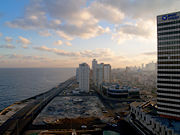
Contemporary Havana can essentially be described as three cities in one: Old Havana, Vedado, and the newer suburban districts. Old Havana, with its narrow streets and overhanging balconies, is the traditional centre of part of Havana's commerce, industry, and entertainment, as well as being a residential area.
To the north and west a newer section, centred on the uptown area known as Vedado, has become the rival of Old Havana for commercial activity and nightlife. Centro Habana, sometimes described as part of Vedado, is mainly a shopping district that lies between Vedado and Old Havana. The Capitolio Nacional marks the beginning of Centro Habana, a working class neighborhood, where a lot of buildings are almost in a total state of collapse [19]. Chinatown and The Real Fabrica de Tabacos Partagás, one of Cuba's oldest cigar factories is located in the area[20].
A third Havana is that of the more affluent residential and industrial districts that spread out mostly to the west. Among these is Marianao, one of the newer parts of the city, dating mainly from the 1920s. Some of the suburban exclusivity was lost after the revolution, many of the suburban homes having been nationalized by the Cuban government to serve as schools, hospitals, and government offices. Several private country clubs were converted to public recreational centres. Miramar located west of Vedado along the coast, remains Havana's exclusive area; mansions, foreign embassies, diplomatic residences, upscale shops, and facilities for wealthy foreigners are common in the area[21]. The International School of Havana is located in the Miramar neighborhood.
In the 1980s many parts of Old Havana, including the Plaza de Armas, became part of a projected 35-year multimillion-dollar restoration project. The government sought to instill in Cubans an appreciation of their past and also to make Havana more enticing to tourists in accordance with the government's effort to boost tourism and thus increase foreign exchange.
Architecture
- Neo-classical
Havana is unique due to its unrivalled rhythmic arcades built largely by Spanish immigrants. Many interior patios remain similar to designs in Seville, Cadiz and Granada. Neo-classicism affected all new buildings in Havana and can be seen all over the city. Many urban features were introduced into the city at the time including Gas public lighting in 1848 and the railroad in 1837. In the second half of the 18th century, sugar and coffee production increased rapidly, which became essential in the development of Havana's most prominent architectural style. Many wealthy Habaneros took their inspiration from the French; this can be seen within the interiors of upper class houses such as the Aldama Palace built in 1844. This is considered the most important neoclassical residential building in Cuba and typifies the design of many houses of this period with portales of neoclassical columns facing open spaces or courtyards.

In 1925 Jean-Claude Nicolas Forestier, the head of urban planning in Paris moved to Havana for five years to collaborate with architects and landscape designers. In the master planning of the city his aim was to create a harmonic balance between the classical built form and the tropical landscape. He embraced and connected the city’s road networks while accentuating prominent landmarks. His influence has left a huge mark on Havana although many of his ideas were cut short by the great depression in 1929. During the first decades of the 20th century Havana expanded more rapidly than at any time during its history. Great wealth prompted architectural styles to be influenced from abroad. The peak of Neoclassicism came with the construction of the Vedado district (begun in1859). This whole neighbourhood is littered with set back well-proportioned buildings.

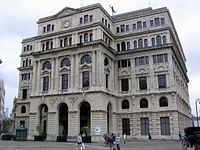
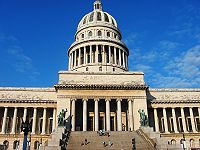
- Colonial and Baroque
Great riches were brought from the colonialists into and through Havana as it was a key transshipment point between the new world and old world. As a result Havana was the most heavily fortified city in the Americas. Most examples of early architecture can be seen in military fortifications such as La Fortaleza de San Carlos de la Cabana (1558 - 1577) designed by Juan Antonelli and the Castillo del Morro (1589 - 1630). This sits at the entrance of Havana Bay and provides an insight into the supremacy and wealth at that time. Old Havana was also protected by a defensive wall begun in 1674 but had already overgrown its boundaries when it was completed in 1767, becoming the new neighbourhood of Centro Habana.
The influence from different styles and cultures can be seen in Havana's colonial architecture, with a diverse range of Moorish, Spanish, Italian, Greek and Roman. The Convento de Santa Clara (1638 - 18th century) is a good example of early Spanish influenced architecture. Its great hall looks resembles an inverted ship and shows the skill of early craftsmen. The Havana cathedral (1748 -1777) dominating the Plaza de la Caterdral (1749) is the best example of Cuban Baroque. Surrounding it are the Condes de Casa-Bayona (1720 -1746) Marqueses de Arcos (1746) and the Marqueses de Aguas Claras (1751 -1775).
- Art Nouveau, Art Deco and Eclectic
At the turn of the 20th century Havana, along with Buenos Aires, was the grandest and most important Latin American city in terms of architecture. This boom period known as vacas gordas (fat cows) demonstrates huge examples of buildings from the international influences of art nouveau, art deco and eclectic. Its suburbs developed to what we see today as Miramar, Marianao, Vedado and Playa. The lush and wealthy Miramar was set out on the American street grid pattern and became a home to diplomats and foreigners. The railway terminal (1912) and the University of Havana, (1906 -1940) and the Capitolio (1926 - 1929) are a good example of the art nouveau style. The Capitolio dome was at 62 meters the highest point in the city and an example of the influence and wealth deriving from the USA at the time. The Lopez Serrano building built in 1932 by Ricardo Mira was the first tall building in Cuba and inspired by the Rockefeller Center in New York. Its design influence can be seen in many buildings in Miami and Los Angeles. The Edificio Bacardi (1930) is one of Havana's grandest buildings and it's best example of Art Deco. Located on a small knoll overlooking the entrance to Havana Bay, is the art-deco style Hotel Nacional de Cuba; originally built in 1929-30 through a joint agreement with the Cuban government and U.S.-based bank.
- Modernism
Havana, like Las Vegas in the 40s and 50s developed from marketing itself as a destination for gambling and holidays in the sun. It became a haven for criminals, and gangsters. Many high-rise office buildings, and apartment complexes, along with some hotels approved by Fulgencio Batista government helped dramatically alter the skyline. Modernism, therefore, transformed much of the city and should be noted for its individual buildings of high quality rather than its larger key buildings. Examples of the latter are Habana Libre (1958), which before the revolution was the Havana Hilton Hotel and La Rampa movie theater (1955). Famous architects such as Walter Gropius, Richard Neutra and Oscar Niemeyer all passed through the city while strong influences can be seen in Havana at this time from Le Corbusier and Ludwig Mies van der Rohe.
The Edificio Focsa (1956) represents Havana's booming economy and foreign influence at the time. This 35-story complex was conceived and based on Corbusian ideas of a self-contained city within a city. It contained 400 apartments, garages, a school, a supermarket, and restaurant on the top floor. This was the tallest concrete structure in the world at the time (using no steel frame) and the ultimate symbol of luxury. The Havana Riviera Hotel (1957) designed by Irving Feldman, a twenty-one-story, 440-room edifice, towering above the Malecon in Havana was another angular and futuristic building build on the Vedado area impressive for its era. When it opened, the Riviera would be the largest purpose-built casino-hotel in Cuba or anywhere in the world, outside Las Vegas (the Havana Hilton (1958) surpassed its size a year later). It was build by Meyer Lansky to equal the comfort and contemporary luxury of any Las Vegas hotel of the era. Jose Luis Sert had also designed an artificial island off the Malecón whose construction was planned to take place in the 1960s. It was to incorporate huge modern towers, hotels, casinos, and shopping centers which would cater for the city's growing tourism. This like many other post-1959 projects never materialized and western Havana never fully achieved its intended direction. High-rise buildings were to replace some Colonial blocks and buildings mainly around this previously loosely developed western part of the city, mainly the Vedado and Playa area. It would have drastically altered Havana's profile, marking a new era of significant contemporary growth for the city. It would have created a new more diverse Havana of modernistic appeal on the west accompanying its past glory of abundant colonial and eclectic architecture in Old Havana and Centro Habana on the east.
Landmarks
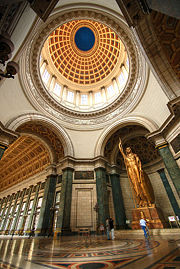
- Fortaleza San Carlos de la Cabaña a fortress located on the east side of the Havana bay. La Cabaña is the most impressive fortress from colonial times, particularly its walls constructed (at the same time as El Morro) at the end of the 18th century.
- El Capitolio Nacional , it was built in 1929 as the Senate and House of Representatives (and said to be a replica of Washington DC's Capitol), this colossal building is recognizable by its dome which dominates the city's skyline. Inside stands the largest indoor bronze statue in the world representing Pallas Athena. Nowadays, the Cuban Academy of Sciences headquarters and the Museo Nacional de Historia Natural (the National Museum of Natural History) has its venue within the building and contains the largest natural history collection in the country.
- Castillo de los Tres Reyes Magos del Morro is a picturesque fortress guarding the entrance to Havana bay. The construction of the castle Los Tres Reyes del Morro was due to the step along in Havana of the English pirate Sir Francis Drake.
- Castillo San Salvador de la Punta is a small fortress built in the 16th century, at the western entry point to the Havana harbour, played a crucial role in the defence of Havana during the first centuries of colonisation. The fortress still houses some twenty old guns and other military antiques.
- El Cristo de La Habana - Havana's statue of Christ blesses the city from the other side of the bay, much like the famous Cristo Redentor in Rio de Janeiro. Carved from marble by Jilma Madera, it was erected in 1958 on a platform which makes a good spot from which to watch old Havana and the harbour.
- The Great Theatre of Havana is famous particularly for the acclaimed National Ballet of Cuba. It sometimes hosts performances by the National Opera. The theater is also known as concert hall, Garcia Lorca, the biggest in Cuba.
- Hotel Nacional de Cuba, Art Deco National Hotel.
- El Malecón Habanero is the avenue that runs along the seawall built along the northern shore of Havana, from Habana Vieja to the Almendares River, forming the southern boundary of Old Havana, Centro Habana and Vedado.
- Museo de la Revolución, located in the former Presidential Palace, with the yacht Granma on display behind the museum.
- Necrópolis Cristóbal Colón - cemetery and open air museum[22] It is one of the most famous cemeteries in Latin America, known for its beauty and magnificence. The cemetery was built in 1876 and has nearly one million tombs. Some of the gravestones are decorated with the works of sculptors of the calibre of Ramos Blancos, among others.
Culture
Havana, by far the leading cultural centre of the island, offers a wide variety of features that range from museums, palaces, public squares, avenues, churches, fortresses (including the largest fortified complex in the Americas dating from the 16th through 18th centuries), ballet and from art and musical festivals to exhibitions of technology. The restoration of Old Havana offered a number of new attractions, including a museum to house relics of the Cuban revolution. The government placed special emphasis on cultural activities, many of which are free or involve only a minimal charge.

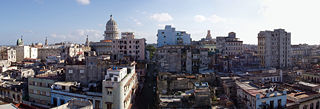
- Old Havana
Old Havana, (La Habana Vieja in Spanish), contains the core of the original city of Havana, it is the richest colonial set of Latin America. Havana Vieja was founded by the Spanish in 1519 in the natural harbor of the Bay of Havana. It became a stopping point for the treasure laden Spanish Galleons on the crossing between the New World and the Old World. In the 17th century it was one of the main shipbuilding centers. The city was built in baroque and neoclassic style. Many buildings have fallen in ruin during the communist period in the later half of the 20th century, but a number are being restored. The narrow streets of old Havana contain many buildings, accounting for perhaps as many as one-third of the approximately 3,000 buildings found in Old Havana.[23]
Old Havana is the ancient city formed from the port, the official center and the Plaza de Armas. Alejo Carpentier called Old Havana the place "de las columnas" (of the columns). The Cuban government is taking many steps to preserve and to restore Old Havana, through the Office of the city historian, directed by Eusebio Leal.[24] Old Havana and its fortifications were added to the UNESCO World Heritage List in 1982.[25]
- Chinatown
- Further information: Chinese Cuban
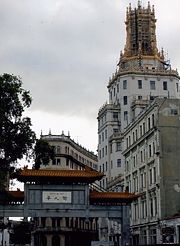

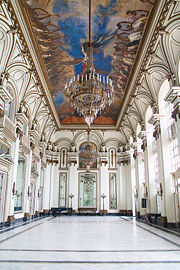


Havana's Chinatown (Barrio Chino), once Latin America's largest and most vibrant Chinatown incorporated into the city by the early part of the 20th century when hundreds of thousands of Chinese workers were brought in by Spanish settlers from Hong Kong, Macau, and Taiwan during the following decades to replace and / or work alongside African slaves. After completing 8-year contracts or otherwise obtaining their freedom, many Chinese immigrants settled permanently in Havana. The Chinatown neighborhood was booming with Chinese restaurants, laundries, banks, pharmacies, theaters and several Chinese-language newspapers, the neighborhood comprised 44 square blocks during its prime[26]. The heart of Havana's chinatown is on el Cuchillo de Zanja (or The Zanja Canal). The strip is a pedestrian-only street adorned with many red lanterns, dancing red paper dragons and other Chinese cultural designs, there is a great number of restaurants that serve a full spectrum of Chinese dishes.
The Chinatown district has two paifang, a large one located on Calle Dragones, the materials were donated in the late 90s by the People's Republic of China [27], it has a well defined written welcoming sign in Chinese and Spanish. The smaller arch is located on Zanja strip. The Cuban's Chinese boom ended when Fidel Castro's 1959 revolution seized private businesses, sending tens of thousands of business-minded Chinese fleeing, mainly to the United States and abroad. Age, emigration and intermarriage have taken a toll on Havana's once flourishing Chinese community. While descendants are making efforts to preserve and revive the culture, the island's last pure Chinese are slowly disappearing into Havana's Chinese cemetery, taking with them part of Cuba's history.
Only one of what were once four Chinese-language newspapers remains in Havana, Kwong Wah Po, written by Abel Fung, member of the Promotional Group of Chinatown [28]. The newspaper is not subject to state censorship. To tie in with the Revolution's economic reliance on tourism, attempts have recently been launched to attract revitalization investment for Chinatown from state-run enterprises of the People's Republic of China and overseas Chinese private investors, particularly Chinese Canadians. In addition, Chinatown is today the only area granted autonomy from many laws that govern the rest of Cuba. Restaurants, for example, are not state run nor are they subject to the laws of private restaurants in that they are allowed to have more than 12 seats as well as serve seafood.
- Visual arts
A small palace located on 17th Street and E, is the very well maintained neo-classical mansion of the Countess of Revilla de Camargo, today it is the Museum of Decorative Arts (Museo de Artes Decorativas), known as the small French Palace of Havana built between 1924 and 1927, it was designed in Paris by architects P. Virad and M. Destuque, inspired in French Renaissance[29]. A lavish display of 18th and 19th century European treasures that recall a time when Havana was known as the Paris of the Antilles, and many luxury goods, including porcelain from Worcester, Meissen and Sevres, were imported [30]
In the French room, a marble bust of Marie Antoinette smiles demurely, her graceful neck intact. There is another room full of Chinese screens, another one featuring English furniture and landspcape painting. For more than 40 decades the museum has been exhibiting more than 33,000 works dating from the reigns of Louis XV, Louis XVI, and Napoleon III; as well as XVI to XX Century Oriental pieces, among many other treasures[31]. The Museum has ten permanent exhibit halls with works that range from the XVI to the XX centuries. Among them are prominent porcelain articles from the factories in Sèvres and Chantilly, France; Meissen, Germany; and Wedgwood, England, as well as Chinese from the Kien Lung period and Japanese from the Imari. The furniture comes from Leonard Boudin, Simoneau, Jean Henri Riesener and several others.
The National Museum of Fine Arts is a Fine Arts museum that exhibits Cuban art collections from the colonial times up to contemporary generation. There are two impressive buildings, one dedicated to Cuban Art and the Universal Art, in the former Asturian Center[32], the former Fine Arts Museum built in 1954 is dedicated exclusively to housing Cuba Art collections. Several museums in Old Havana contain furniture, silverware, pottery, glass and other items from the colonial period. A great one of these is the Palace of the General Captains, where Spanish governors once lived. The Casa de Africa presents another aspect of Cuba's history, an impressive collection of Afro-Cuban religious artifacts.
The Museo Nacional de Bellas Artes containing works by Rubens, Goya and Velazquez is now closed for renovations; it is open to public at a temporary location on Calle Trocadero until renovations are complete. Other museums includes Casa de los Árabes and the Casa de Asia with Middle and Far Eastern collections. Many of these small boutiques museums are in elegant old Spanish architecture houses with airy courtyards. The Museo de Finanzas is more than an empty vault where dictator Fulgencio Batista once stashed his loot. A few old bank-notes are displayed on the walls. Havana's Museo del Automobil has an impressive collection of vehicles dating back to a 1905 Cadillac. In the Automobile museum there is also a Rolls Royce which belonged to Batista, near the 1960 Chevrolet that Che Guevara drove.
There Museum of the Revolution (Museo de la Revolución), designed in Havana by Cuban architect Maruri, and the Belgian Jean Beleu, who came up with an eclectic design, which harmoniously combines Spanish, French and German architectural elements. The museum was the Presidential Palace, today, its displays and documents outline Cuba's history from the beginning of the neo-colonial period. As most museums of Havana are situated in Old Havana few of them could also be found in Vedado. In total, Havana has around 50 museums, including the Museum of Fine Art, the Revolution and Decorative Arts; the National Museum of Music; the Museum of Dance and Rum; the Cigar Museum; the Napoleonic, Colonial and Oricha Museums; the Museum of Antropology; the Ernest Hemingway Museum; the Jose Marti Monument; Museums of Natural Sciences, the City, Archeology Museum, and Gold-and Silverwork. Also the Aircraft, Parfume, Pharmaceutical, Sports, Numismatic and Weapons Museums.
- Performing arts
After the sun sets, Havana's performing arts come to life, facing the Central Park is the faux-baroque Great Theatre of Havana, a prominent theatre built in 1837 home of the National Ballet of Cuba and the International Ballet Festival of Havana, one of the oldest in the New World and remarkably was once the most technologically advanced in the world, thanks to the Italian scientist, Antonio Meucci.[33]
It is said the experiments of the eccentric inventor who arrived in Havana in 1835 produced electrical lightning effects and an internal telephone system long before Edison or Bell. Meucci's ingenious spirit lives on in the theatre. Located in the Paseo de Prado in a building known as the Palacio del Centro Gallego. The façade of the building is adorned with a stone and marble statue. There are also sculptural pieces by Giuseppe Moretti,[34] representing allegories depicting benevolence, education, music and theatre. The principal theatre is the García Lorca Auditorium, with seats for 1,500 and balconies. Glories of its rich history; the Italian tenor Enrico Caruso sang, the Russian ballerina Anna Pavlova danced, and the French Sarah Bernhardt acted.
Another grand theatre is the National Theater of Cuba, housed in a huge modern building, decorated with works by Cuban artists. There are two main theatre stages, the Avellaneda hall and the Covarrubias hall, as well as a smaller theatre workshop space on the ninth floor. The Karl Marx Theater is the venue has an enormous auditorium with seating capacity of 5500 people, and is generally used for big shows by stars from Cuba and abroad. The theatre is also a major concert venue for both local and international artists; singer-songwriters such as Carlos Varela, Silvio Rodríguez and Pablo Milanés, are just a few of the famous artists who have graced this particular stage. More recently, this was the scene of a concert by British pop group The Manic Street Preachers.
Economy
Industry
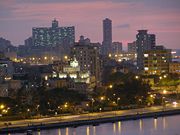

Havana's economy first developed on the basis of its location, which made it one of the early great trade centres in the New World. Sugar and a flourishing slave trade first brought riches to the city, and later, after independence, it became a renowned resort. Despite efforts by Fidel Castro's government to spread Cuba's industrial activity to all parts of the island, Havana remains the centre of much of the nation's industry. The traditional sugar industry, upon which the island's economy has been based for three centuries, is centred elsewhere on the island and controls some three-fourths of the export economy. But light manufacturing facilities, meat-packing plants, and chemical and pharmaceutical operations are concentrated in Havana. Other food-processing industries are also important, along with shipbuilding, vehicle manufacturing, production of alcoholic beverages (particularly rum), textiles, and tobacco products, particularly the world-famous Habanos cigars.[35] Although the harbours of Cienfuegos and Matanzas, in particular, have been developed under the revolutionary government, Havana remains Cuba's primary port facility; 50% of Cuban imports and exports pass through Havana. The port also supports a considerable fishing industry.
Following the collapse of the Soviet Union in 1991 and the United States embargo against Cuba, Havana and the rest of Cuba suddenly plunged into its worst economic crisis since the 1959 Revolution, the crisis was known officially as the Special Period in Time of Peace. The effects of the Special Period and consequent food shortages have had greatest repercussions in the city of Havana. With approximately 2.5 million people, Havana has about one fifth of Cuba's total population and is the largest city in the Caribbean. In addition to the decline in food production needed to serve the capital, there is also a shortage of petroleum necessary to transport, refrigerate, and store food available from the rural agricultural sector. Havana has been designated as a priority in the National Food Program; urban gardening has figured critically among the many measures taken to enhance food security. After the collapse of the Soviet Union, Cuba re-emphasized tourism as a major industry, which today is Havana and Cuba's primary economic source [36].
Tourism
Before the triumph of the revolution in 1959 – and particularly from 1915 to 1930 - tourism was one of Cuba’s major sources of hard currency (behind only the sugar and tobacco industries). Havana, where a kind of laisser-faire attitude in all things leisurely was the norm, was the Caribbean’s most popular destination, particularly with US citizens, who sought to skirt the restrictions of prohibition America.
Following a severe drop in the influx of tourists to the island (resulting, primarily, from the Great Depression, the end of prohibition in the United States and the outbreak of World War II), Havana began to welcome visitors in significant numbers again in the 1950s, when US organized crime secured control of much of the leisure and tourism industries in the country. This was a time when Cuba’s foreign minister boasted that Havana spent as much on parties as any major capital in the world, when the island was the mob’s most secure link in the drug-trafficking chain which culminated in the United States and when the country’s justified reputation for sensuality and dolce vita pursuits earned it the appellation of “the Latin Las Vegas”. Meyer Lansky built the Hotel Riviera, Santo Trafficante came to own shares in the Sevilla and a casino was opened at the Hotel Plaza during this time.
It was tourism’s association to the world of gambling and prostitution which made the revolutionary government established in 1959 approach the entire sector as a social evil to be eradicated. Many bars and gambling venues were closed down following the revolution and a government body, the National Institute of the Tourism Industry, took over many facilities (traditionally available to wealthy) to make them accessible to the general public.
With the deterioration of Cuba – US relations and the imposition of a trade embargo on the island in 1961, tourism dropped drastically and did not return to anything close to its pre-revolution levels until 1989. The revolutionary government in general, and Fidel Castro in particular, initially opposed any considerable development of the tourism industry, linking the sphere to the debauchery and criminal activities of times past. In the late 1970s, however, Castro changed his stance and, in 1982, the Cuban government passed a foreign investment code which opened a number of sectors, tourism included, to foreign capital.
Through the creation of firms open to such foreign investment (such as Cubanacan, established in 1987), Cuba began to attract capital for hotel development, managing to increase the number of tourists from 130,000 (in 1980) to 326,000 (by the end of that decade).
As a result of the collapse of the Soviet Union and its Eastern European allies in 1989 and early 90s, Cuba was plunged into a severe economic crisis and saw itself in desperate need of foreign currency. The answer, again, was found in tourism, and the Cuban government spent considerable sums in the industry to attract visitors. Following heavy investment, by 1995, the industry had become Cuba’s main source of income.
Commerce and finance
Under the government of Fidel Castro, Cuba's traditional free-enterprise system was replaced by a heavily socialized economic system. The majority of business in Cuba is in the hands of the state. In Havana Cuban-owned businesses and U.S.-owned businesses were nationalized and today most businesses operate solely under state control. In Old Havana and throughout Vedado there are a several small private businesses, such as shoe-repair shops or dressmaking facilities, but their number is steadily declining. In general, as a result of this extreme centralized economy by the communist regime there is an extreme economic stagnation seen throughout the city and countless buildings have become vacant, abandoned, and beyond repair. Banking as well is totally under state control, and the National Bank of Cuba, headquartered in Havana, is the control center of the Cuban economy. Its branches in some cases occupy buildings that were in pre-revolutionary times the offices of Cuban or foreign banks.
Vedado is today Havana's financial district, the main banks, airline companies offices, shops, most businesses headquarters, numerous high-rise apartments and hotels, are located in the area[37]. In the late 1990s Vedado, located along the Caribbean waterfront, started to represent the principal commercial area. It was developed extensively between 1930 and 1960, when Havana developed as a major destination for U.S. tourists; high-rise hotels, casinos, restaurants, and upscale commercial establishments, many reflecting the art deco style[38]. The University of Havana is located in Vedado.
Transportation
Transport
- Further information: Transportation in Cuba


Nationally, public transport in Cuba is directed by the Ministerio del Transporte (MITRANS). In the Province of the City of Havana, Provincial Transport Authority functions are carried out by 11 divisions.
Public transport must be self-financing. Until 1994, general government funds from MITRANS (of around $US4 million per annum) were used to fund the Provincial Transport Directorate in the City of Havana budget. Public transport in Havana has always been able to cover operating expenses that are paid in Cuban Pesos through the fares. But there has been a constant problem with financing fuel, new vehicles and spare parts and other supplies which require hard currency like US dollars – which led to a reduction in service provision. To address this, enterprises that generate hard currency (like the tourist taxis, tourist rental cars, and tourist cocotaxi elements of Panatrans and the Transmetro services that hire out buses and trucks to dollar-owning companies) cross subsidise the other services, in particular OM and MetroBus.
In addition, a service planning team from the Regional Transit Authority of Paris (RATP) has been working to redefine the public transport network in the capital. The main aim of this project has been to rationalise the number of existing routes to match the actual passenger demand. The first of these new principal routes has already been put into place.
- Air
Havana is served by José Martí International Airport. It lies about 11 km south of the city center, and is the main hub of Cubana de Aviación. José Martí International Airport is Cuba's main international and domestic getaway, it is also hub of Aerogaviota and Aero Caribbean. The airport serves several million passengers each year, 80% of Cuba's international passengers along with Varadero's Airport, it handles flights from over 25 international airlines serving more than 60 worldwide destinations, mainly in Europe, North, Central and South America and over 3 national airlines serving 16 domestic destinations. Havana is also served by Playa Baracoa Airport which is small airport to the west of city used for some domestic flights, primarily Aerogaviota.
- Rail
Havana has a network of suburban, interurban and long-distance rail lines, the only one in the Caribbean region. The railways are nationalised and run by the UFC (Union de Ferrocarriles de Cuba – Union for Railways of Cuba). Rail service connects Havana from the Central Rail Station, La Coubre' and Casablanca stations to various Cuban provinces. Currently annual passenger volume is some 12 million, but demand is estimated at two-and-a-half to three times this value, with the busiest route being between Havana and Santiago de Cuba, some 836 km apart by rail. In 2000 the Union de Ferrocarriles de Cuba bought French first class airconditioned coaches.
Fast trains line 1 and 2 between Havana (Central Station) and Santiago de Cuba use comfortable stainless-steel air-conditioned coaches bought from French Railways and now known as "el tren francés" (the French train). It runs daily at peak periods of the year (Summer season, Christmas & Easter), and on every second day at other times of the year. These coaches were originally used on the premier Trans Europ Express service between Paris, Brussels and Amsterdam before being replaced with high speed Thalys trains. They were shipped to the Cuban Railways System in 2001. It offers two classes of seating, basic leatherette "especial" and quite luxurious "primera especial".
- Bus
The Havana public buses are carried out by two divisions, Omnibus Metropolitanos (OM) and MetroBus. The Omnibus Metropolitanos division has one of the most used and largest urban bus fleets in the country, its fleet is widely diverse in new and old donated bus models, primerally well used Busscar Urbanuss manufactured by Mercedes-Benz with an additional new 255 purchased in 2004.[39] The Cuban government will invest $2,000 million dollars for the acquisition of 1,500 new Yutong urban buses and another 1,000 interprovincial buses in a 5 years period. There are several inter-province bus services such as Astro, the regular National public transportation, Astro connects the capital city with all over the island, in 2005 Astro completely replaced its fleet with brand new Yutong buses.
The Metrobus division are known as "camellos" (camels). The camellos operate the busiest routes and are trailers transformed into buses known as camels, so called for their two humps. It's a Cuban invention after the collapse of the Soviet Union in 1991 and the Special Period began. The Metrobus division purchased seven articulated buses which are currently serving the M-5 camello line, covering a route from San Agustín in La Lisa municipality to Vedado. All camello trailers will be replaced by new articulated buses.
Public transportation MetroBus (former camello) routes:
- M-1 Alamar - Vedado via Fraternidad
- M-2 Fraternidad - Santiago de las Vegas
- M-3 Alamar - Ciudad Deportiva
- M-4 Fraternidad - San Agustin via Marianao
- M-5 Vedado - San Agustin
- M-6 Calvario - Vedado
- M-7 Parque de la Fraternidad - Alberro via Cotorro
Administration
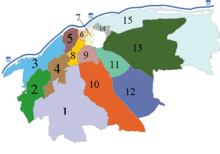


Government
Havana is administered by a city council, with a mayor as chief administrative officer. The city is dependent upon the national government, however, for much of its budgetary and overall political direction. The national government is headquartered in Havana and plays an extremely visible role in the city's life. Moreover, the all-embracing authority of many national institutions, including the Communist Party of Cuba (Partido Comunista de Cuba; PCC), the Revolutionary Armed Forces (Military of Cuba), the militia, and neighbourhood groups called the Committees for the Defense of the Revolution (CDRs), has led to a declining role for the city government, which, nevertheless, still provides such essential services as garbage collection and fire protection. The CDRs, which exist in virtually every street and apartment block, have two main functions: first, to actually defend the revolution against both external and internal opposition by keeping routine record of every resident's activities and, second, to handle routine tasks in maintaining neighborhoods.
Havana city borders are contiguous with the Habana Province. Thus Havana functions as both a city and a province. There are two joint councils upon which city and provincial authorities meet—one embraces municipal and provincial leaders on a national basis, the other, a Havana city and provincial council. Havana is divided into 15 constituent municipalities. Until 1976 there were six subdivisions, but in that year the city's borders were expanded to include the entire metropolitan area.
Municipios
The city is divided into 15 municipios - municipalities or boroughs. (Numbers refer to map above).
| Municipality | Population (2004) |
Area (km²) |
Location | Remarks |
|---|---|---|---|---|
| Arroyo Naranjo | 210,053 | 83 | (10) | |
| Boyeros | 188,593 | 134 | (1) | |
| Centro Habana | 158,151 | 4 | (6) | |
| Cerro | 132,351 | 10 | (8) | |
| Cotorro | 74,650 | 66 | (12) | |
| Diez de Octubre | 227,293 | 12 | (9) | |
| Guanabacoa | 112,964 | 127 | (13) | |
| La Habana del Este | 178,041 | 145 | (15) | |
| La Habana Vieja | 95,383 | 5 | (7) | |
| La Lisa | 131,148 | 38 | (2) | |
| Marianao | 135,551 | 21 | (4) | |
| Playa | 186,959 | 36 | (3) | |
| Plaza de la Revolución | 161,631 | 12 | (5) | |
| Regla | 44,431 | 9 | (14) | |
| San Miguel del Padrón | 159,273 | 26 | (11) |
Demographics
Havana's rich cultural milieu included not only Spaniards from diverse regions of the Iberian Peninsula but other European peoples as well. In the era before Fidel Castro came to power, the city was economically and ethnically divided. On the one hand, there was the minority of the wealthy, educated elite, together with a strong middle class, and on the other was the working-class majority. This division was largely based on ethnic background: whites tended to be more well-to-do, while blacks and mulattoes generally were poor. The economic structure did not provide much opportunity for blacks and mulattoes except in the more menial occupations. There was also little opportunity for them to obtain an education. Under the Castro government that came to power in 1959, this system changed. Educational and employment opportunities were made available to Cubans of all ethnic backgrounds; however, top positions and fields of study were usually reserved only to signed communist party members and record showed supporters, though this has lost some strictness in recent years. In housing, the government follows an official policy of no discrimination based on ethnic background, and independent observers tend to believe this policy has been more or less faithfully carried out.
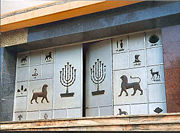
During the 18th, 19th and early part of the 20th century, large waves of Canarian, Catalan, and Galicians emigrated from the Iberian Peninsula to Havana.
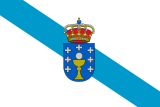 Galician people
Galician people Canarian people
Canarian people Catalan people
Catalan people
The Cuban government controls the movement of people into Havana on the grounds that the Havana metropolitan area (home to nearly 20% of the country's population) is overstretched in terms of land use, water, electricity, transportation, and other elements of the urban infrastructure. There is a population of internal migrants to Havana nicknamed "Palestinos" (Palestinians); these mostly hail from the eastern region of Oriente.[42] Havana has a significant minority of Chinese, before the revolution the Chinese population counted to over 200,000[43], today Chinese born or ancestors could count up to 100,000[44]. Havana also shelters a non-Cuban population of an unknown size, including Russians majorly living in Habana del Este that constantly emigrated during the Soviet era. There is a population of several thousand North African teen and pre-teen refugees.[45]
Roman Catholics form the largest religious group in Havana. The Jewish community in Havana has reduced after the Revolution from once having embraced more than 15,000 Jews[46], many of whom had fled Nazi persecution and subsequently left Cuba to Miami or returned to Israel after Castro took to power in 1959. The city once had five synagogues, but only three remain (one Orthodox, one Conservative and one Sephardic). In February 2007 the New York Times estimated that there were about 1,500 known Jews living in Havana.[47]
Infrastructure

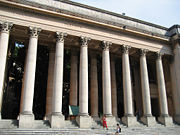
Education
- Further information: Education in Cuba
The national government assumes all responsibility for education, and there are adequate primary, secondary, and vocational training schools throughout Havana. The vocational Cuban National Ballet School with 4,350 students is the biggest ballet school in the world and the most prestigious ballet school in Cuba [48], directed by Ramona de Sáa. In 2002 with the expansion of the school, out of 52,000 students interested to join the school, 4,050 were selected [49]. The government claims that all children receive an education, and the claim appears to be valid. The schools are of varying quality and education is free and compulsory at all levels except higher learning, which is free nonetheless. The University of Havana, located in the Vedado section of Havana, was established in 1728 and was once regarded as a leading institution of higher learning in the Western Hemisphere. Soon after Castro came to power in 1959, the university lost its traditional autonomy and was placed under the control of the government. The city's only other university, the respected Catholic University in Marianao, was closed after the revolution. Since then several other universities have opened, like the Polytechnic Institute "Joe Antonio Echeverria" where the vast majority of today's Cuban engineers are formed.
Health
- Further information: Healthcare in Cuba
Under the Cuban government all citizens are covered by the national health care plan. Administration of the health care system for the nation is centred largely in Havana. Hospitals in Havana are run by the national government, and citizens are assigned hospitals and clinics to which they may go for attention. During the 1980s Cuba began to attract worldwide attention for its treatment of heart diseases and eye problems, some of this treatment administered in Havana. There has long been a high standard of health care in the city.
Services
Utility services are under the control of several nationalized state enterprises that have developed since the Castro Cuban revolution. Water, electricity, and sewage service are administered in this fashion. Electricity is supplied by generators that are fueled with oil. Much of the original power plant installation, which operated before the Castro government assumed control, has become somewhat outdated. Electrical blackouts occurred, prompting the national government in 1986 to allocate the equivalent of $25,000,000 to modernize the electrical system. It is said that any part of Havana is within five minutes of a fire-fighting unit; the equipment is largely new.
Sports
Many Cubans are avid sports fans who particularly favour baseball. Havana's two baseball teams in the Cuban National Series are Industriales and Metropolitanos. The city has several large sports stadiums, the largest one is the Estadio Latinoamericano. Admission to sporting events is generally free, and impromptu games are played in neighborhoods throughout the city. Social clubs at the beaches provide facilities for water sports and include restaurants and dance halls.
- Havana was host to the 11th Pan American Games in 1991. Stadiums and facilities for this were built in the relatively unpopulated eastern suburbs.
- Havana was host to the 1992 IAAF World Cup in Athletics.
- Havana was a candidate to host the 2012 Summer Olympic Games, but was not shortlisted.
Notable people born in Havana
See also Category:People from Havana (category)
- Felipe Poey, zoologist (1799–1891)
- José Martí, poet, writer, nationalist leader (1853–1895)
- Ernesto Lecuona, composer, performer (1895–1963)
- Dulce María Loynaz, author (1902–1997)
- Orestes López, musician (1908-1991)
- Cundo Bermúdez, painter (1914-)
- Alicia Alonso, Prima Ballerina Assoluta (1920–)
- María Antonieta Pons, actress, Rumba dancer (1922–2004)
- Celia Cruz, singer (1925-2003)
- Elena Burke, singer (1928–2002)
- Alberto Korda, photographer, famous for his photo "Guerrillero Heróico" of Che Guevara (1928-2001)
- Camilo Cienfuegos, revolutionary along with Fidel Castro and Che Guevara (1932–1959)
- Ricardo Alarcón, politician, president of the National Assembly of Cuba (1937–)
- Cristina Saralegui, journalist, talk show host (1948–)
- Oswaldo Payá, political activist (1952–)
- Alina Fernández, daughter and a critic of Fidel Castro (1956–)
- Andy García, actor (1956–)
- Maria Teresa, Grand Duchess of Luxembourg, grand ducal consort of Grand Duke Henri of Luxembourg (1956–)
- Gloria Estefan, singer (1957–) (emigrated to the U.S. as a child)
- Carlos del Junco, musician (1958–)
- César Évora, actor (1959–)
- Alfredo Alonso, broadcasting executive (1960-)
- Juan Contino Aslán, politician, city mayor of Havana (1960-)
- Dave Lombardo, heavy metal drummer (1965–)
- Felipe Pérez Roque, politician, foreign minister of Cuba (1965-)
- Humberto Padrón, film director (1967–)
- Pedro Álvarez Castelló, painter, (1967-2004)
- Rey Ruiz, musician (1970–)
- Amarilis Savón, judoka (1974–)
- Vyacheslav Kernozenko, Ukrainian football goalkeeper (1976–)
- William Levy, actor (1979–)
- Mario Cimarro, actor (1971-)
- Yotuel Romero, musician (1976–)
- Al Jourgensen, musician (1958-)
Sister cities
Havana has twinning agreements with the following sister cities:
|
References
Notes
- ↑ Largest Cities in the Caribbean
- ↑ Créditos
- ↑ (Spanish) ""Ciudad (con mayúscula) de La Habana, así se llama la provincia donde se encuentra ubicada la capital de Cuba."". Retrieved on 2007-02-10.
- ↑ (English) Latin America Population - Havana city population.
- ↑ (English) Capital city - capital of Spanish Cuba in 1552
- ↑ (English) Old Havana
- ↑ (English) Spanish-American War -Effects of the Press on Spanish-American Relations in 1898
- ↑ http://uncpress.unc.edu/chapters/scarpaci_havana.html
- ↑ (Spanish) Historia de la India Habana
- ↑ Thomas, Hugh : Cuba, A pursuit of freedom 2nd Edition p.1
- ↑ 12.0 12.1 Pocock, Tom : Battle for Empire : The very first world war 1756-63. Chapter Six
- ↑ 13.0 13.1 13.2 Thomas, Hugh : Cuba : The Pursuit of Freedom 2nd edition. Chapter One
- ↑ Arquitextos - Periódico mensal de textos de arquitetura
- ↑ Ernest Hemingway life - Homing To The Stream: Ernest Hemingway in Cuba.
- ↑ Old Havana restoration - Success on the restoration program of Havana
- ↑ [1] Havana, Cuba's history with tropical systems
- ↑ "Average Weather for Havana, --Temperature and Precipitation". weather.com. Retrieved on 06-22, 2008.
- ↑ Centro Habana- Centro Habana guia turistica, Cuba
- ↑ Centro Habana
- ↑ Havana Miramar School
- ↑ Havana's magnificent necropolis tells a story of wealth and freedom
- ↑ [2]3,000 buildings found in Old Havana
- ↑ [3]Cuban Restoration Project Pins New Hopes on Old Havana
- ↑ Habana Vieja - UNESCO World Heritage List
- ↑ Havana's Chinatown - The once largest Chinatown in Latin America
- ↑ El Barrio Chino de la Habana - Havana's Chinatown (Spanish)
- ↑ Chinatown is fading with age in Cuba - Kwong Wah Po, only remaining Chinese newspaper in Cuba
- ↑ Museo de Artes Decorativos- José Gómez Mena, one of Cuba's wealthiest aristocrats, built this house in 1927 to hold his staggering collection of antique furniture, rugs, paintings and vases.
- ↑ (Spanish) Trabajadores Newspaper article- Las artes decorativas también tienen su Museo en La Habana.
- ↑ (Spanish) Paseos por La Habana-El museo guarda en su interior mobiliario antiguo, porcelana y ceramica, cristalerias, espejos, bronces y objetos ornamentales.
- ↑ (Spanish) Centro Asturiano de La Habana- Museo de Arte Universal. Centro Asturiano de La Habana (1927)
- ↑ Antonio Meucci- In Havana he constructed a system for waters depuration and reprojected the Gran Teatro, which had been almost entirely destroyed by a hurricane.
- ↑ (Spanish) Radio Havana-Cuba- Existen también piezas escultóricas en las cuatro cúpulas del techo realizadas por Giuseppe Moretti.
- ↑ The economy of Havana
- ↑ Tourism in Cuba during the Special Period
- ↑ Vedado (district, Havana, Cuba) - This part of the city, built largely in the 20th century, contains attractive homes, tall apartments, and offices along wide, tree-lined boulevards and avenues.
- ↑ Vedado- De una casa colonial a una mansión del Vedado
- ↑ "International transportation fair in Havana Business in excess of $100 million, Granma national newspaper note
- ↑ Atenas.cu (2004). "2004 Population trends, by Province and Municipality". Retrieved on 2007-10-06. (Spanish)
- ↑ Statoids (July 2003). "Municipios of Cuba". Retrieved on 2007-10-06.
- ↑ Castro’s Cuba in Perspective
- ↑ Havana's Chinatown - Cuba's Chinese population before the Revolution
- ↑ CIA World Factbook. Cuba. 2006. September 6, 2006.<https://www.cia.gov/library/publications/the-world-factbook/geos/cu.html>.
- ↑ "Sahrawi children inhumanely treated in Cuba, former Cuban official". MoroccoTimes.com (March 31 2006). Retrieved on 2006-07-09.
- ↑ Present-Day Jewish Life in Cuba
- ↑ 1,500 Jews who live in Cuba; 1,100 reside in Havana, and the remaining 400 are spread among the provinces.In Cuba, Finding a Tiny Corner of Jewish Life.
- ↑ (Spanish) La Escuela Nacional de Ballet - La Escuela desarrolla una experiencia única en el mundo, enmarcada en la Batalla de Ideas.
- ↑ (Spanish) Escuela Nacional de Ballet - entre 52 mil alumnos interesados, los cuatro mil 50 que integrarían los talleres.
- ↑ Barcelona sister cities
- ↑ Beijing-International Sister Cities
- ↑ Invitation for fraternization of Havana and Belgrade
- ↑ Cusco Sister Cities
- ↑ City of Esfahan official website - Sister Cities
- ↑ Glasgow City Council - Twin cities of Glasgow
- ↑ Erdem, Selim Efe (2003-11-03). "İstanbul'a 49 kardeş" (in Turkish), Radikal. "49 sister cities in 2003"
- ↑ "Hermanamientos y Acuerdos", www.munimadrid.es.
- ↑ Sister Cities International (2007). "Cuba Directory". Retrieved on 2007-05-07.
- ↑ Oaxaca Sister Cities - Relación de la ciudades hermanadas con la ciudad de Oaxaca
- ↑ Granma - En La Habana vicealcalde de la ciudad de Rotterdam -La delegación visitante hará la entrega oficial de una donación de implementos deportivos, en momentos en que se celebra el aniversario 25 de las relaciones entre ambas urbes
- ↑ Saint Petersburg in figures - International and Interregional Ties
- ↑ Memoria Anual, Agosto 2002-Agosto 2003
- ↑ São Paulo's 40 Sister Cities
- ↑ Tehran, Havana named sister cities
- ↑ New Monument to Tijuana's sister cities - Inaugura el alcalde Kurt Honold monumento dedicado a ciudades hermanas de Tijuana
Sources
- Havana: History and Architecture of a Romantic City. Alicia García Santana. Monacelli, October 2000. ISBN 1-58093-052-2.
- The Rough Guide to Cuba (3rd ed.). Rough Guides, May 2005. ISBN 1-84353-409-6.
- Barclay, Juliet (1993). Havana: Portrait of a City. London: Cassell. ISBN 1-84403-127-6 (2003 paperback edition). — A comprehensive account of the history of Havana from the early 16th century to the end of the 19th century.
- Carpentier, Alejo. La ciudad de las columnas (The city of columns). — A historical review of the city from one of the major authors in the iberoamerican literature, a native of this city.
- Cluster, Dick, & Rafael Hernández, History of Havana. New York: Palgrave-MacMillan, 2006. ISBN 1-4039-7107-2. A social history of the city from 1519 to the present, co-authored by a Cuban writer and editor resident in Havana and an American novelist and writer of popular history.
- Eguren, Gustavo. La fidelísima Habana (The very faithful Havana). — A fundamental illustrated book for those who wants to know the history of La Habana, includes chronicles, articles from natives and non natives, archives documents, and more.
- United Railways of Havana. Cuba: A Winter Paradise. 1908-1909, 1912-1913, 1914-1915 and 1915–1916 editions. New York, 1908, 1912, 1914 and 1915. Maps, photos and descriptions of suburban and interurban electric lines.
- Electric Traction in Cuba. Tramway & Railway World (London), 1 April 1909, pp. 243-244. Map, photos and description of Havana Central Railroad.
- The Havana Central Railroad. Electrical World (New York), 15 April 1909, pp. 911-912. Text, 4 photos.
- Three-Car Storage Battery Train. Electric Railway Journal (New York), 28 September 1912, p. 501. Photo and description of Cuban battery cars.
- Berta Alfonso Gallol. Los Transportes Habaneros. Estudios Históricos. La Habana, 1991. The definitive survey (but no pictures or maps).
- Six Days in Havana by James A. Michener and John Kings. University of Texas Press; 1ST edition (1989). ISBN 978-0292776296. Interviews with close to 200 Cubans of widely assorted backgrounds and positions, and concerns how the country has progressed after 90 years of independence from Spain and under the 30-year leadership of Castro.
- One more interesting note about that edition of the New York Times: On page 5, there is a short blurb mentioning, "The plan for holding a Pan-American exhibition at Buffalo has been shelved for the present owing to the unsettled condition of the public mind consequent upon the Spanish-Cuban complications." President McKinley was assassinated at the Pan-American Exhibition when it was finally held in 1901.
External links
- Havana City Map
- Havana travel guide from Wikitravel
- Map of Havana. To zoom in, click on an area of the map. These are very large High resolution JPEG images (~1 Megabyte)
- Wikia has a wiki on this subject at Havana
|
|||||||||||||||||
|
|||||
|
|||||||
|
|||||||||||||||||

